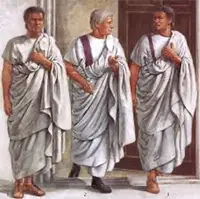The Praetorian Guard
The Praetorian Guard was a squad of personal bodyguards for the Roman Emperor. They numbered in the thousands and played a direct role in the ascension and several emperors. In the days of the Roman Republic, it was not uncommon for a civil or military leader to have a bodyguard(s). Mentions of such an arrangement date to the 3rd Century B.C. 
During the civil wars of the 1st Century B.C., a few of those strugglers to take control had their own cohort of bodyguards. Notably, during the final struggle between Octavian and Marc Antony, both of those commanders had a personal retinue of bodyguards. When Octavian emerged victorious, he appointed Antony's bodyguards as his own. When Octavian became Augustus and the Empire began, the Emperor created the Praetorian Guard. At that time, the Guard consisted of nine cohorts of at 500 men (so 4,500 in total), who were tasked with defending the Emperor and his family. They acted as a sort of secret police and also had crowd control duties at times during Games in the arena, in one instance making sure that participants and slaves taking part in a mock naval battle that involved real-life casualties didn't escape the arena. Another of the official duties of the Guard was to serve as emergency firefighters. (They acted in this capacity during the time of the Great Fire, in 64.) 
The Guard wore civilian, not military, clothing but carried a short sword, which they hid inside the toga. Augustus, in 2 B.C., created two leaders of the Guard, the Prefects, who were both directly responsible to the Emperor and who were the only two men allowed to have a weapon on them when they were with the Emperor. The second Emperor, Tiberius added three cohorts to the Guard, bringing the total to 12. The highest number of cohorts was 16, the increase coming at the behest of Vitellius, in the Year of the Four Emperors; as well, each of those 16 cohorts contained 1,000 men. The emperor Vespasian cut the number back to the original nine; his son, the emperor Domitian, added one more, to bring the number to 10; in both cases, the number in each cohort remained 1,000. 
In the 1st Century and the 2nd Century, emperors added a cavalry cohort, which had 500 and then 1,000 members, and then ordered the Guard into battle alongside the imperial legions; when they did this, the members of the Guard wore armor and helmets and wielded shields and javelins and spears. In some cases, the Praetorian Prefect would be in charge of all of the soldiers (unless the Emperor was present, in which case the Prefect would be the second-in-command, enforcing orders from the top). Members of the Guard served for 16 years. (The one exception to this was for an eight-year period in the 1st Century B.C., during which Augustus reduced the service time to 12 years.) By contrast, a soldier in a legion would serve 25 years. As well, the pay to members of the Guard was one-and-one-half times as much as that paid to legionary soldiers. Emperors generally deployed the Guard at various points around the city of Rome and elsewhere, ostensibly to keep them separate. At their inception, the members of the Guard were dispersed throughout Italy, with only three of the original cohorts being stationed in the Eternal City. The emperor Tiberius ordered the construction of the Praetorian Camp, in which all cohorts eventually lived. Located just outside the boundaries of Rome proper, this camp was a fortress surrounded by very high and very solid walls. The Guard was instrumental in securing a bloodless succession after the assassination of the emperor Caligula (some sources say by the Guard's own hand) by insisting the Claudius was the rightful emperor, despite his physical difficulties. The Guard played also a part in the confusion that reigned in 69, the Year of the Four Emperors. It helped future Emperors ensure the Guard's loyalty to pay members of the Guard a sum of money to keep them happy. Vespasian, the last of the Four Emperors in that year, ensured loyalty in a different way by appointing his son Titus as one of the Prefects. 
The Guard is known to have played a part in the execution of Pertinax, in 193, the Year of the Five Emperors and then sold the throne to the highest bidder, who happened to be Didius Julianus (right), after a promise of giving each member of the Guard the equivalent of five years' pay, all at once. The Guard reached the height of power in 217, when Macrinus, a Prefect, enjoyed the acclamation as Emperor after the arranging the assassination of the emperor Caracalla. Just a few years before that, the emperor Septimius Severus, had dismissed all members of the Guard and replaced them with men he trusted from the legions. In the confusion and civil war that ended with Constantine becoming Emperor, the Guard threw in its lot with Maxentius. When Constantine became Emperor in his own right, he disbanded the Guard. |
|
Social Studies for Kids
copyright 2002–2024
David White




